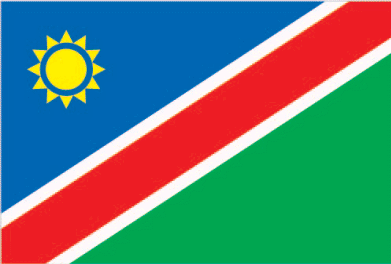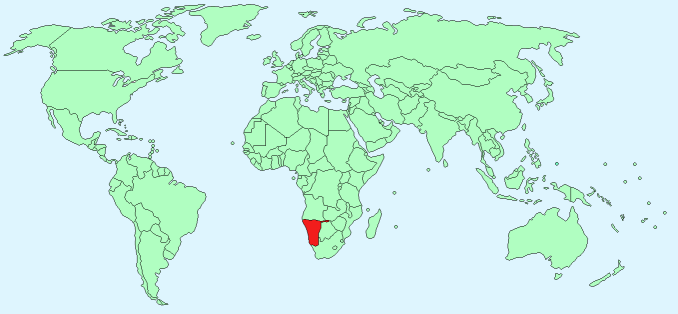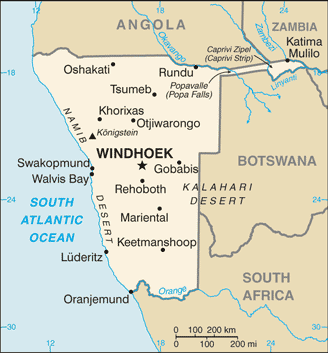Namibia


Continent – Africa
Region – Southern Africa
Size – 824,292 km²
Geography – high plateau and desert
Language – Afrikaans 10.4%, English 3.4% (official), indigenous languages 87.2%
Religion – Christian 85%, indigenous beliefs 15%
Monetary Unit – Namibian dollar
Natural Resources – diamonds, copper, uranium, gold, silver, lead, tin, lithium, cadmium, tungsten, zinc, salt, hydropower, fish
Agriculture – millet, sorghum, peanuts, grapes; livestock; fish
Industry – meatpacking, fish processing, dairy products, pasta, beverages; mining (diamonds, lead, zinc, tin, silver, tungsten, uranium, copper)

Neighbouring Countries – Angola, Zambia, Botswana, South Africa
Population – 2,212,307 (2014)
Population Growth Rate – 0.59%
Average Life Expectancy – 51.64
Capital City – Windhoek (population 356,000)
Highest Mountain – Konigstein (2,606 m)
Longest River – Orange (2,200 Namibia, South Africa and Lesotho)
Climate – Plateau – Warm winters 10°C to 20°C and hot summers 17°C to 30°C, Desert – hot winters 20°C to 25°C and very hot summers 30°C to 40°C
Yearly Rainfall – 60cm mainly in the north east
Plant Life – quiver tree, leadwood tree, devil’s claw, hoodia, opane, terminalia, marula, giant figs, baobabs, aloe dichotoma
Animal Life – wild dog, black rhino, white rhino, puka antelope, elephant, lion, buffalo, cheetah, leopard, giraffe, antelope, impala, mice, gerbils, bats, meerkats, mongoose, jackal
Marine Life – dolphins, seals, sharks
Bird Life – Herero chat, rockrunner, Monteiro’s hornbill and Damara tern, African fish eagle, ostrich, grebe, penguin, albatross, pelicans, cormorants, bitterns, gulls, terns,
Harvard Reference for this page:
Heather Y Wheeler. (2015). Namibia. Available: https://www.naturalhistoryonthenet.com/Facts_Figures/Country_Facts/namibia.htm. Last accessed Tuesday, July 19, 2016
Facts and Figures Pages
